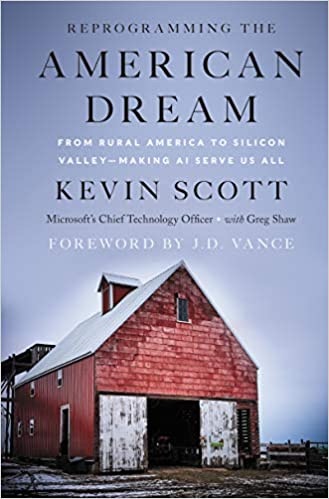
Reprogramming the American Dream: From Rural America to Silicon Valley – Making AI Serve Us All by Kevin Scott finds a balance between “the robots are coming for our jobs” and “AI is great, nothing to worry about.” Like Kevin, I believe that all citizens need to educate themselves regarding the promises and perils of AI. That is clearly the purpose of this book. It won’t make you an expert in AI, but it will give you many clues. In addition to citizens, AI experts, policymakers, and executives are also Kevin’s intended audiences.
Introduction
- There are two prevailing stories about AI. For low and middle-skill workers, we hear a grim tale of steadily increasing job destruction. For knowledge workers, we hear an idyllic tale of enhanced productivity and convenience. But neither captures the whole story. The story we need is AI’s potential to create abundance and opportunity for everyone as it helps solve the world’s most vexing problems. Kevin’s story is based on his upbringing in rural Virginia and his life as executive vice president and chief technology officer for Microsoft.
- We know AI will radically impact economics and employment and we are already seeing it perform very specific, narrow tasks like selecting the ads you see, turning speech to text, and translating languages. He sees a future where workers at all skill levels are served. While AI was invented in the US, China’s goal is to become the leader and thus dictate policy regarding this technology. In order to have a voice in the debate you need to be informed, which is the goal of this book.
PartI: Where We’ve Been – 1. When Our Jobs First Went Away
- Kevin returns to his rural home and visits old friends who are using simple versions of AI to harvest sod, monitor nursing home patients, and manufacture specialized plastic parts. The latter demonstrates how technology is allowing some manufacturing jobs to return to the US. In the case of the sod farmer, drones using AI are saving human jobs. In essence, AI can empower people rather than replacing them. He also visits a large Microsoft data center that replaced an obsolete prison. The local college even started a program to train workers. The challenge is to convince high school graduates that there is a better future in a technology job than in oil and gas jobs which might pay $60,000 to start, but are heavy labor jobs that over time, pay little more than the initial offer.
2. The Career Choice I Made
- This chapter is largely autobiographical. Kevin tells his story from home to college to a small engineering company in Lynchburg, VA, to graduate school at the Univerity of Virginia where he met his future wife. When she was accepted to a PhD program in Götingen, Germany he was able to get a job there too. From there he went from Google to AdMob, to Google, to LinkedIn. LinkedIn was acquired by Google in 2016 and ultimately he was chosen by Saya Nadella the CEO to be Microsoft’s chief technology officer (CTO).
- Along the way Keven stresses the importance of his supportive family and community in rural Virginia. While they were not rich he never lacked for food or housing and hand mentors and role models that supplemented his education. He didn’t have health care until he got to Google but never got sick either. While he doesn’t think you should base all of your career decisions on income, you should consider the economics of the choices you make. Get as much data and good advice as you can and reflect prior to making important life choices. For companies, he stresses the importance of stories. They need to be stories that employees can make their own and they need to be connected to how their work can somehow make the world a better place.
3. Stories of Revival
- The stories here focus on rural life and opportunities. In 2016 75% of venture funding went to Silicon Valley, New York, and Boston. Kevin tells the success story of Memphis that now has the world’s largest cargo airport. AI is making inroads in agriculture with robots that do precision irrigation and drones that apply fertilizer and pesticides in just the right quantities and locations. Kevin offers some ideas of how the government can incentivize rural entrepreneurship. His big idea is to have an Apollo type program for AI. The Apollo program only cost $200 billion in the 1960s to get to the moon so it should be possible to do the same for AI.
- We need a system to make rural people better at tech so they can run and debug drones, robots, and other high tech farm equipment. There is some effort in this direction. We also need to break down the stereotypes that urban and rural people have of each other. The media that people currently consume is part of the problem as many people binge on unhealthy information. He switched his consumption to 75% refereed journals like Science and Nature, 25$ to learning something new and different not related to his job, and 5% for everything else. Doing so made him less anxious, irritated, and much better informed.
DrDougGreen.com If you like the summary, buy the book





